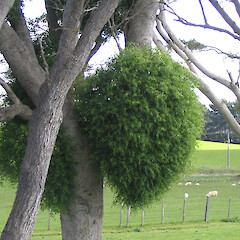Tupeia antarctica
Common name
Tāpia, pirita, white mistletoe, tupia, kohuorangi
Synonyms
Viscum antarcticum G.Forst., V. pubigerum A.Cunn., Tupeia cunninghamii Miq. T. pubigera Miq.
Family
Loranthaceae
Flora category
Vascular – Native
Endemic taxon
Yes
Endemic genus
Yes
Endemic family
No
Structural class
Trees & Shrubs - Dicotyledons
NVS code
The National Vegetation Survey (NVS) Databank is a physical archive and electronic databank containing records of over 94,000 vegetation survey plots - including data from over 19,000 permanent plots. NVS maintains a standard set of species code abbreviations that correspond to standard scientific plant names from the Ngä Tipu o Aotearoa - New Zealand Plants database.
TUPANT
Chromosome number
2n = 24
Current conservation status
The conservation status of all known New Zealand vascular plant taxa at the rank of species and below were reassessed in 2017 using the New Zealand Threat Classification System (NZTCS) – more information about this can be found on the NZTCS website. This report includes a statistical summary and brief notes on changes since 2012 and replaces all previous NZTCS lists for vascular plants.
Please note, threat classifications are often suggested by authors when publications fall between NZTCS assessment periods – an interim threat classification status has not been assessed by the NZTCS panel.
- Conservation status of New Zealand indigenous vascular plants, 2017 . 2018. Peter J. de Lange, Jeremy R. Rolfe, John W. Barkla, Shannel P. Courtney, Paul D. Champion, Leon R. Perrie, Sarah M. Beadel, Kerry A. Ford, Ilse Breitwieser, Ines Schönberger, Rowan Hindmarsh-Walls, Peter B. Heenan and Kate Ladley. Department of Conservation. Source: NZTCS and licensed by DOC for reuse under the Creative Commons Attribution 4.0 International licence.
2017 | At Risk – Declining | Qualifiers: PD
Previous conservation statuses
2012 | At Risk – Declining | Qualifiers: CD
2009 | At Risk – Declining | Qualifiers: CD
2004 | Gradual Decline
Brief description
Rounded shrub to 1m wide growing on other trees with white bark, finely hairy rounded twigs (lens needed), fleshy variously-shaped bright green leaves and whiteish to pinkish fruit. Leaves 10-70mm long. Flowers tiny.
Distribution
Endemic to the North and South Islands.
Habitat
Forest or scrub (often in regenerating vegetation), where it is parasitic on a wide range of hosts including tarata, karo, Coprosma species, putaputaweta, fivefinger, white maire and broom.
Detailed description
A shrubby semi-parasite to 1 m diameter. Leaves are oppositely arranged, variable in shape, 10 to 70 by 10 to 40 mm, slightly fleshy and bright green. Stems are always rounded in cross section near the tips, have pale white to grey bark, and downy or hairy branchlets. Flowers are tiny, greenish-yellow. Fruit are fleshy, white to pink, 5 to 7 mm diameter.
Similar taxa
Peraxilla colensoi, P. tetrapetala and Trilepidea adamsii all have colourful flowers. Ileostylus micranthus has tiny, yellow-green flowers, a ‘bent’ style, yellow fruit and young stems that are squarish in cross-section and have multiple attachments to its host. All these species are hairless.
Flowering
Flowers from October to December.
Flower colours
Green, Yellow
Fruiting
Fruit appear from December to March.
Propagation technique
Difficult. Has been grown successfully by some people but many others have failed. Best success is achieved with seed that has been sown fresh (within one to two days of harvesting) onto a suitable host.
Threats
Possum browse is the primary threat to this species. Insect browse, habitat destruction, loss of pollinating and seed-dispersing native birds, collectors, vandalism and fungal disease also threaten this species.
Etymology
tupeia: Named after Tupaia (c. 1725 – December, 26 1770) who was a Tahitian Polynesian navigator and arioi (a kind of priest), originally from the island of Ra’iatea in the Pacific Islands (see Chamisso & Schlechtendal, 1828).
antarctica: Antarctic
Cultural Use/Importance
This species will on occasion extend into beech forest where it has been found parasitic on red mistletoe (Peraxilla tetrapetala). Favoured indigenous hosts include Pseudopanax arboreus, Carpodetus serratus, Nestegis cunninghamii, Pittosporum eugenoides, P. tenuifolium, and Coprosma spp. At present the species has been recorded from 48 hosts (11 exotic) spread through 32 genera and 20 families (de Lange et al. 1997), though this figure needs revision as since that time many more hosts have been reported.
Attribution
Fact sheet prepared by P.J. de Lange for NZPCN (1 June 2013)
References and further reading
Chamisso, L.K.A.; Schlechtendal, D.F.L. 1828: Lorantheae pp. 203-204. Linnaea 3(3): 200-219.
de Lange, P.J.; Norton, D.A.; Molloy, B.P.J. 1997: An annotated checklist of New Zealand mistletoe (Loranthaceae) hosts. Pp. 83-104. In: de Lange P.J.; Norton, D.A. (eds.) New Zealand’s loranthaceous mistletoes. Conference proceedings. Wellington, Department of Conservation.
NZPCN Fact Sheet citation
Please cite as: de Lange, P.J. (Year at time of access): Tupeia antarctica Fact Sheet (content continuously updated). New Zealand Plant Conservation Network. https://www.nzpcn.org.nz/flora/species/tupeia-antarctica/ (Date website was queried)





















